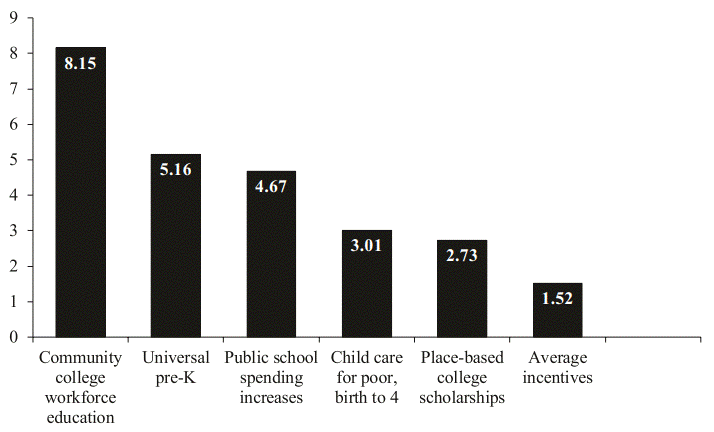Memphis is not investing in its workforce. This was stated last week in a meeting of workforce practitioners. For years, Memphis has been transferring wealth, under the heading of “economic development” to real estate developers and corporations to serve global audiences. At the same time, by design, Memphis falls behind in the global economy while dismissing a major economic development asset – its youthful population.
Last week, in Commission Chambers, I asked if Memphis Tomorrow, Republicans or Democrats had any research to support that excessive tax incentives actually work. There were no answers and the data shows they don’t work. So how might local legislators renegotiate economic development more around workforce development ? The simple answer is by using research.
First, it has to be determined that excessive incentives is a budget committee issue. And to renegotiate economic development in favor of workforce, budget chairs will need the support of those committee chairs that are over youth and workforce development.
While connecting the workforce, youth and workforce development chairs would be advocating for economic development funding for programs like the Southwest CC Foundation, 9-12 Early Postsecondary Opportunities (EPSOs), Memphis Office of Youth Services, Junior Achievement and professional development. Legislators would further call for major private sector assistance to help Memphis catch up in the global economy while renegotiating economic development funding.
Renegotiating Using a Research Base
Next, in this sample renegotiation, Dr. Timothy Bartik’s research Making Sense of Incentives will be used. The research is designed specifically for policymakers. In his research, Bartik states that less than 25% of economic impact is derived from incentives. The 25% is referred to as the “but for” percentage meaning that less than 25% of the time but for the incentive the economic expansion would not take place.
In his economic modeling, Bartik uses a 12% “but for” percentage. Local policymakers should do the same in their renegotiation of incentives. To that extent, customized for Memphis conditions, we can model a sample renegotiation of Memphis/Shelby tax incentive policy.
Commissioner and Councilman Jones and Jones, using a research base, would like Bartik, start the negotiation at 12%. Then corporate/real estate incentive advocates would push back and claim Memphis needs greater incentives due to high crime, workforce challenges and a high property tax rate.
Jones and Jones would recognize these Memphis challenges while stating that Memphis has a low business cost operating environment negating the high property tax rate claim while adding 5% for each high crime and challenging workforce which actually needs more funding. Legislative workforce advocates would lend their support to the Budget Chairs. And a “but for” of roughly 25% would be derived for the average incentive.
In this way, we can apply the adjusted “but for” percentage and recalculate EDGE’s economic impact from their EDGE SCORECARD down from $1.4B to $356M. This recalculation would show EDGE operating at a total projected taxpayer loss of $236M. So over a 10 year span, there is a $24M per year in excess going to corporate/real estate incentives and not to workforce for years to come and where advocates for a better workforce should be up in arms. With flat property tax revenues, service gaps in public transit and workforce challenges, the recalculation makes sense of the current environment.
At any rate, in this modeling, the 25% is the average “but for” percentage. To get to a sensible implementation of economic development policy to arrive at an average “but for” of 25%, low wage warehousing jobs and existing companies would have a “but for” percentage much less than 25% while companies relocating to Memphis in target industries would have a “but for” higher than 25% in calculating and sizing incentives.
Making the Economic Development Case in Favor of Workforce
Bartik’s research has gifted advocates of workforce development with a research based tool to make the case for workforce within the context of economic development. The chart below, from Bartik’s research, shows the economic impact of investing in workforce compared to incentives.
For example investments in Southwest Foundation would garner a 8.15 taxpayer benefit to cost ratio compared to 1.52 for incentives. And investments in EPSOs, which is a K-12/Post Secondary investment, can be calculated using the below chart, to have a 6 taxpayer benefit to cost ratio compared to 1.52 for the average incentive.
In the current environment, Memphis workforce development practitioners, should feel confident in making the research based business case for workforce development public and private sector funding within the context of economic development.
Conclusion
With flat property tax revenues draining off needed public funding for workforce development, the data is clear, sufficient economic development investments are not being made in workforce.
Excessive corporate/real estate incentives and unmeasured public-private initiatives are keeping Memphis behind in the global economy. Based on available benchmarking data, Memphis incentives are even excessive even compared to the environment that Bartik is questioning in his research.
Renegotiating economic development with corresponding major infusions by the private sector in workforce is the only path to competitive growth while helping Memphis catch up in the global economy.
About Bartik’s Research
Dr. Timothy Bartik’s Making Sense of Incentives research that centers on state incentives, is designed for policymakers and specifically mentions local legislative bodies. While there are a number of ways to evaluate incentives, Bartik’s work provides just another research based methodology to evaluate incentives.


